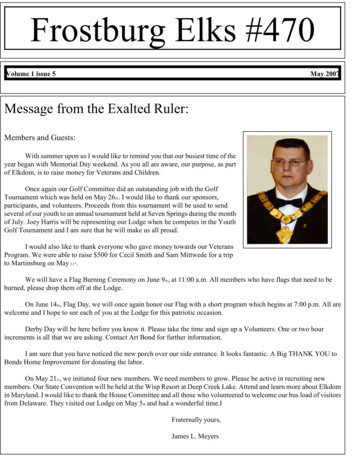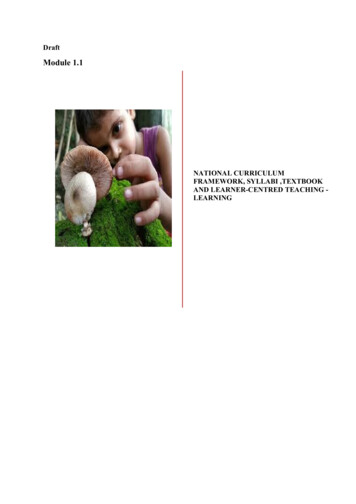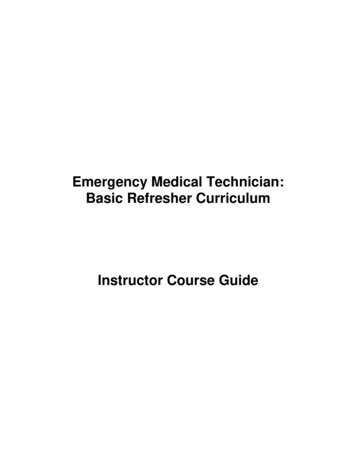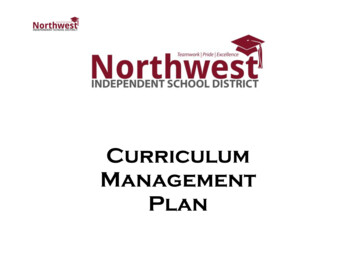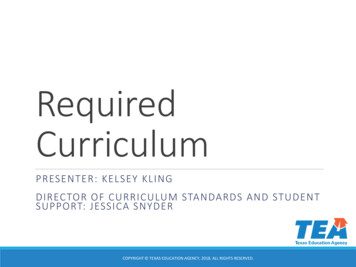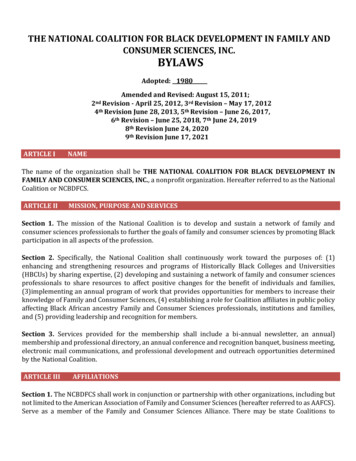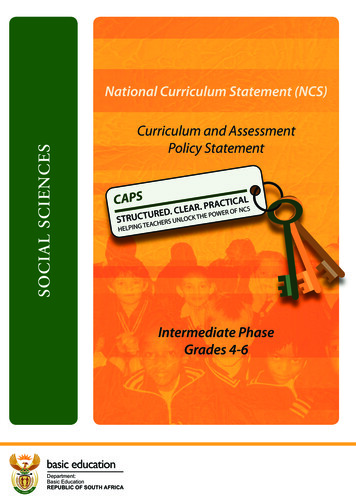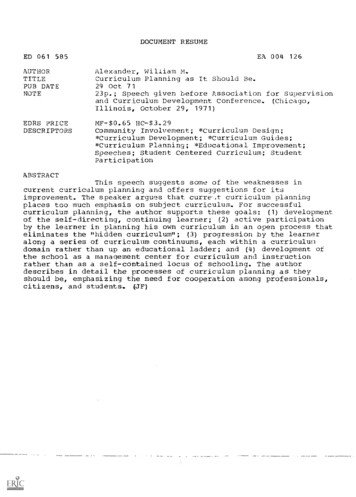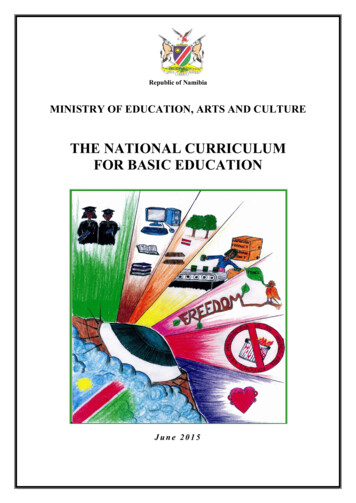
Transcription
3333Republic of NamibiaMINISTRY OF EDUCATION, ARTS AND CULTURETHE NATIONAL CURRICULUMFOR BASIC EDUCATIONJune 2015
Illustration done by Theresa Maasdorp, a Grade 12 learner atJ G van der Wath Secondary School in 2009, OkahandjaTitle: Namibia Vision 2030Explanation by Ms Maasdorp:There is a cloud of smoke, in it is the Namibian flag and at the end there is an eye. Thisrepresents the Namibian cloud of vision – a vision through an eye.The diagrammes within the rays (anti-clockwise from the bottom):1. The hearts hugging represent a caring society. You will notice the hearts are differentcolours, representing different nations.2. The rubbish tin contains the burning of HIV and Aids. Total eradication or limiting thenumber of persons infected. It represents a healthy society.3. The bird represents freedom, the twig that grew into the word ‘Freedom’ alsorepresents the fact that freedom does not come in 30 seconds. It comes with the years,as Namibia grows. It represents a democratic society.4. The conveyer belt and the boxes represent a productive nation that exports and not justimports. We produce most of our own products.5. There are two trees and two log bundles. These represent an environmentally friendlysociety, where the amount of raw materials used equals the amount produced. Thenumber of trees planted equals the number of logs cut for timber.6. The computers and books represent an information society. We have access to internetand information - we have books to read and to be educated.7. The graduating girl and boy represent individual development.National Institute for Educational Development (NIED)Ministry of Education, Arts and CulturePrivate Bag 2034OkahandjaNamibiawww.nied.edu.na Copyright NIED, Ministry of Education, Arts and Culture, 2015THE NATIONAL CURRICULUM FOR BASIC EDUCATIONISBN: 0-86976-911-1Printed by NIEDFirst publication date 2009Revised edition 2015
FOREWORDRapid changes such as technological advances, globalisation, HIV and AIDS, andenvironmental degradation make it necessary to re-evaluate the guidelines governing thepurpose and content of education.The National Curriculum for Basic Education replaces the Pilot Curriculum Guide for FormalBasic Education (1996) as well as the Pilot Curriculum Guide for Formal Senior SecondaryEducation (1998), ensures continuity of the foundation principles of the Namibian educationsystem as described in Toward Education for All: A Development Brief (1993). The goal,aims, competencies, core skills and key learning areas have been identified in relation toNamibia Vision 2030 and are presented as a curriculum for the future.The framework serves as the official curriculum policy for Formal Basic Education inNamibia. It guides schools on how to organise the teaching-learning process and provide acoherent framework to ensure that there is consistency in the delivery of the curriculum inschools throughout the country.Selecting what children should learn has always been complex. A developing world makes itessential that the curricular framework has to adapt to change. The knowledge, skills, valuesand attitudes which learners can acquire are infinite. The developers have made a carefulselection of the timeless and the new, in order to find a delicate balance to ensure that ourcurriculum remains relevant. In this manner we strive unceasingly, as we always have,towards equipping the younger generation to deal with both the present and the future.It is my with that this curriculum policy document serves as a roadmap and a companionbooklet to all stakeholders in their drive to make education the success it must become.Should this happen, then a profitable and exciting learning experience beckons for ourlearners.I further wish to extend my appreciation to the people who contributed towards thedevelopment of this special document.The role of teachers is central to successful curriculum delivery. We are confident that whichthe support of the Ministry and the cooperation of stakeholders, including parents and thebroader community, they will empower our learners to become confident, innovative,compassionate and productive members of our society.Hon Katrina Hanse-HimarwaMinister of Education, Arts and Culturei
PLEASE NOTE:The National Curriculum for Basic Education will be supplemented by The InclusiveEducation Curriculum Framework, 2014ii
The National Curriculum for Basic Education, NIED 2015TABLE OF CONTENTS1. INTRODUCTION . 11.11.21.31.41.51.61.71.8BACKGROUND . 1THE PURPOSE AND CONTENT OF THE CURRICULUM FRAMEWORK . 1NAMIBIA VISION 2030 . 2THE CONSTITUTION AND THE EDUCATION ACT . 2EARLY CHILDHOOD DEVELOPMENT AND PRE-PRIMARY EDUCATION . 3THE STRUCTURE AND SUBSTANCE OF BASIC EDUCATION. 3THE APPROACH TO TEACHING, LEARNING AND ASSESSMENT . 5PRECONDITIONS FOR SUCCESSFUL CURRICULUM DELIVERY . 62. THE GOAL AND AIMS OF BASIC EDUCATION FOR A KNOWLEDGE-BASED SOCIETY . 92.1 THE GOAL OF BASIC EDUCATION . 92.2 THE AIMS OF BASIC EDUCATION FOR THE SOCIETY OF THE FUTURE . 93. CORE SKILLS AND KEY LEARNING AREAS . 123.1 CORE SKILLS . 123.2 KEY LEARNING AREAS . 144. PHASES AND COMPETENCIES . 184.1 THE PHASES OF BASIC EDUCATION . 184.2 PHASE OUTCOMES AND COMPETENCIES . 25244.3 FRAMEWORK OF PHASE OUTCOMES . 26255. LANGUAGE: MEDIUM OF EDUCATION AND SUBJECTS. 31305.15.25.35.45.55.66.16.26.36.4IDENTITY, CULTURE, COMMUNICATION, LEARNING . 3130MEDIUM OF LEARNING . 3130LANGUAGE SUBJECTS . 3130FOREIGN LANGUAGES. 3231LANGUAGES AVAILABLE . 3231FACILITATING LANGUAGES FOR LEARNERS WITH SPECIAL EDUCATIONAL NEEDS . 3231TEACHING. 3332LEARNING: EXPERIENCE, REFLECTION, KNOWLEDGE CREATION . 3736ASSESSMENT . 3938PROMOTION . 44437. CURRICULUM MANAGEMENT . 47467.1 MANAGING RESOURCES . 47467.2 TEACHERS . 47467.3 LESSON STRUCTURE . 47467.4 HUMAN RESOURCE UTILISATION. 47467.5 LIFE SKILLS . 48477.6 INCLUSIVE EDUCATION . 49487.7 ORGANISING LANGUAGE TEACHING . 49487.8 TIMETABLING . 49487.9 MULTI-GRADE TEACHING . 497.10 CO-CURRICULAR ACTIVITIES . 50497.11 COMMUNITY RELATIONS . 5049ANNEXE 1: TIME ALLOCATION FOR GRADES 1-7 – . IANNEXE 2: TIME ALLOCATION FOR JUNIOR SECONDARY GRADES 8-9 . IANNEXE 3: TIME ALLOCATION FOR GRADES 10-11 FOR A 7-DAY CYCLE . IIANNEXE 4: TIME ALLOCATION FOR GRADE 12.IIIANNEXE 5: SUBJECT SYLLABUSES .IVANNEXE 6:BACKGROUND DOCUMENTS TO THE NATIONAL CURRICULUM FORBASICEDUCATION. Viii
The National Curriculum for Basic Education, NIED 2015ANNEXE 7: GLOSSARY OF TERMS USED .VIANNEXE 8 STRUCTURE OF THE NAMIBIAN EDUCATION SYSTEM --------------------------------VIIIiv
The National Curriculum for Basic Education, NIED 20151. INTRODUCTIONThe introduction gives a brief overview of the anchoring of the curriculum in policy,legislation and previous developments; a summary of the structure and principles of BasicEducation and preconditions for successful implementation of the curriculum.1.1 BACKGROUNDThe National Curriculum for Basic Education builds on the experience and achievements ofthe first cycle of Namibian curricula and syllabuses that were introduced in the 1990s. Thesewere the curricula for Basic Education (then Grades 1-10), Senior Secondary education, andSpecial Needs education. It continues the foundation laid in The Constitution of The Republicof Namibia (1990), Towards Education for All: A Development Brief (1993), and drawsmainly upon the Report of the Presidential Commission on Education, Culture and Training(1999), The Education Act (2001),The Language Policy for Schools in Namibia (1996), TheLanguage Policy for Schools in Namibia Discussion Document 2003, ICT Policy forEducation (2005), Learner-Centred Education in the Namibian Context: A ConceptualFramework (2003), the Sector Policy on Inclusive Education (2013), Namibia HumanCapital and Knowledge Development for Economic Growth with Equity (2005), curriculumreviews and syllabus revisions by NIED, and other research, monitoring and evaluationreports. It responds to recent changes in Namibian society and to emerging challenges such asglobalisation and HIV and AIDS. It is directed towards helping achieve the nationaldevelopment goals set out in the National Development Programmes 3 and 4, the Educationand Training Sector Improvement Programme (2007), Cabinet Directives on outcomes of the2011 National Education Conference and the long-term perspective of Namibia Vision 2030(2005). 11.2 THE PURPOSE AND CONTENT OF THE CURRICULUM FRAMEWORKThe curriculum is the official policy for teaching, learning, and assessment and givesdirection to planning, organising and implementing teaching and learning. It is theresponsibility of all schools and educational institutions catering for part-time learners toensure that they satisfy the requirements of this curriculum, and those specified in thesyllabuses and other curriculum documents for each phase and subject in Basic Education.The purpose of this curriculum is to provide a coherent and concise framework in order toensure that there is consistency in the delivery of the curriculum in schools and classroomsthroughout the country. It describes the goal, aims and rationale of the curriculum, theprinciples of teaching, learning and assessment, language policy, and curriculummanagement at school level. It makes provision for all learners to follow key learning areas,and outlines the end-of-phase competencies which they should achieve, as well as theattitudes and values to be promoted throughout the curriculum. It outlines the structure ofeach phase, what electives and subject combinations are available and overall time allocation.It sets in place effective assessment procedures, ensuring that assessment is closely integratedin the teaching/learning process.The curriculum is a framework for devising syllabuses, learning materials and textbooks to beused in the various subjects and areas of learning, from which teachers’ schemes of work andlesson plans can be developed, so that the goal and aims will be put into practice in aconsistent manner.1See Annexe 6 for bibliographical details.1
The National Curriculum for Basic Education, NIED 20151.3 NAMIBIA VISION 2030The curriculum has been developed to give direction to Basic Education towards therealisation of Namibia Vision 2030. It ensures continuity of the foundation principles of theNamibian education system described in Toward Education for All: A Development Brief, in1993. The goal, aims, competencies, core skills and key learning areas have been identified inrelation to Namibia Vision 2030 as a curriculum for the future.Namibia Vision 2030 describes the society that Namibia strives to become and the wayforward to achieve it. The vision statement is:VISION 2030A prosperous and industrialised Namibia, developed by her humanresources, enjoying peace, harmony and political stabilityNamibia Vision 2030 sees Namibia as developing from a literate society to a knowledgebased society, a society where knowledge is constantly being acquired and renewed, and usedfor innovation to improve the quality of life. A knowledge-based society requires people whoare healthy, well-educated, skilled, pro-active, and with a broadA knowledge-basedrange of abilities. This needs a high level of human resourcesociety is one wheredevelopment, and Basic Education is the foundation for humanknowledge is created,transformed,and usedresource development for the society of the future. Through BasicforinnovationtoEducation, learners develop the competencies, attitudes and valuesimprove the quality ofneeded for full participation in society by learning to use, acquire,lifeconstruct, evaluate and transform knowledge. Learning to learn is atthe core of this process, and in a knowledge-based society, this continues as lifelong learning.1.4 THE CONSTITUTION AND THE EDUCATION ACTThe curriculum is based on the Constitution of the Republic of Namibia and the EducationAct. The constitution states that education is a right for all persons, and it is the responsibilityof the government to provide education. The Education Act defines Basic Education asGrades 1-12, and as part of the provision demanded by the Constitution, this curriculum setsout the principles and intended learning for Basic Education2.The Constitution states that formal Basic Education is free and compulsory as from thebeginning of the school year when the child reaches the age of 7 until the last school day ofthe year when the child reaches the age of 16, or when they complete primary education, ifbefore then. Under the Education Act (Act no. 16 of 2001), free basic education is extendedto Grade 12, but is not compulsory beyond the limits set in the Constitution. The regulationsof the Education Act state that learners who turn 6 before or on 31st December should beadmitted to school the following year. In cases of overage enrolment, permission must beobtained from the Regional Director of Education if a learner is aged 10 or more before 31stJanuary in the year when they are to start.2Private or home school providers, who want to adapt or supplement this curriculum in any way or use analternative curriculum, must apply to the Minister first for approval to do so.2
The National Curriculum for Basic Education, NIED 2015Free education in the context of Basic Education means that no fees are charged forattendance, tuition, or textbooks. In Grades 11 and 12 no registration fee for the examinationis required. Parents are not expected to provide stationery for the learner such as pens, pencilsand notebooks, and to pay school development fund.1.5 EARLY CHILDHOOD DEVELOPMENT AND PRE-PRIMARY EDUCATIONIn October 2006, the Cabinet took the decision that the responsibility for Pre-PrimaryEducation would be transferred from the Ministry of Gender Equality and Child Welfare tothe Ministry of Education. Consequently, a Pre-Primary school year for 5/6 year-olds becamepart of Basic Education while the Early Childhood phase for 0-4 year-olds will in future, betransferred to the Ministry of Education.Good Early Childhood Development and Pre-Primary programmes provide a stimulatingenvironment for the all-round development of the child which lays a foundation for formalschooling. Universal Pre-Primary education enhances equity on entry to primary education,especially for children with learning disadvantages. Pre-Primary education is not yet a prerequisite for entry to Basic Education, but will be extended as rapidly as possible throughoutthe country.Children who attended Early Childhood Development programmes and/or Pre-Primaryeducation with appropriate pedagogy make better progress in formal education, and achievebetter than those who have not. An appropriate pedagogy is learner-centred through free andstructured play-learning.1.6 THE STRUCTURE AND SUBSTANCE OF BASIC EDUCATIONBasic Education is sub-divided into four phases: Junior Primary (Pre-primary and Grades 13), Senior Primary (Grades 4-7), Junior Secondary (Grades 8-9), and Senior Secondary(Grades 10-12). Formal Basic Education is for all from Pre-Primary to Grade 12. Aftercompletion of Grade 11, there are various opportunities: entry into vocational education andtraining, direct entry to employment, or distance learning. After completion of Grade 11(Ordinary Level), learners who meet the prescribed requirements will progress to Grade 12.Learners will complete subjects on Higher Level and this is an admission requirement tomany universities in Southern Africa and abroad.Note: The Ministry of Education, Arts and Culture intends to introduce Grade 13 in whichlearners will do Advanced (A) Level course/subjects in 2022 in at least one identified andprepared secondary school per region. This will be added to the structure of basic educationand reference to grades in this document will be limited to Grade 12.3
The National Curriculum for Basic Education, NIED 2015Early Childhood DevelopmentJUNIOR PRIMARY(Pre-primary, Grades 1-3)SENIOR PRIMARY(Grades 4-7)- vocational/skills training- Tertiary institutions- distance learning- low-level entry to employment- self-employmentJUNIOR SECONDARY(Grades 8-9)SENIOR SECONDARY(Grade 10-11 Ordinary Level,Grade 12 Higher Level)TertiaryStudiesVocational/Skills TrainingEmploymentSelfemploymentLIFELONG LEARNINGFigure 1: The Structure of Basic EducationThe Junior Primary phase lays the foundation for all further learning. In the Pre-Primary,learners develop communication, motor and social skills, and concept formation, ready tostart formal education. In the Grades one to three the learners learn to read and write in twolanguages; they learn basic mathematics; they learn about the community and nature aroundthem and how to look after their health; and they develop their creative and expressiveabilities. In Pre-Primary, Grades 1-3, teaching and learning are through the medium of theMother Tongue or predominant local language. They are also exposed to computertechnology where they gain a first appreciation of information and communicationtechnologies as a tool for learning, recognition of their functions and uses in their lives, andbasic understanding of how a computer works and how to use it in learning processes.In the Senior Primary phase, learners build on this foundation, develop irreversible literacyand numeracy, and develop learning skills and basic knowledge in Natural Sciences, SocialSciences, Technology, Arts, and Physical Education. A transition to English medium is inGrade 4. Technology skills at this level require a fundamental understanding of softwareapplications and basic navigation skills through the Windows environment.The Junior Secondary phase continues with the same learning areas as Senior Primary,consolidates achievements to date and extends them to a level where the learners are preparedfor young adulthood and continued formal education. At this level, all learners take English,Mathematics and another language. They will be exposed to all learning areas by taking all4
The National Curriculum for Basic Education, NIED 2015science subjects, with options of any two pre-vocational subjects. Those who meet the entryrequirements may continue in formal Senior Secondary education (Grade 10-11), whichprovides specialisation and depth in one area. Those who do not meet the requirements toproceed to grade 10, will repeat the grade 9? Grade 11 is the first exit point in the formalschooling system. Learners who meet requirements may continue to Grade 12. Those who donot meet the requirements have the option to continue their education through distanceeducation.In Grade 10-11, all learners will continue to take English and Mathematics, choose a field ofstudy consisting of three mutually supportive subjects, and take another language, for theGrade 11 examination. Information and Communication Technologies (ICTs) skills at thisstage comprise the confident use of applications and advanced care of a computer. In addition,Life Skills prepares them to meet challenges they will face as young adults and in makingcareer choices. In Senior Secondary, learners will take four to six subjects on Higher Levelthat they passed with the minimum of 40% in Grade 11 except for Namibian Sign Language.At the end of Grade 11 and 12, learners should be well prepared for further study or training,or to enter employment. See the Structure of Namibian Education System in annexe 8.Throughout Basic Education, HIV and AIDS education, Health and Wellness education,Human Rights and Democracy, Information and Communication Technologies (ICTs),Environmental learning and Road Safety are integrated across the curriculum. Each of theseissues deals with particular risks and challenges in our Namibian society.The main risks and challenges have been identified as: the challenges and risks we face if we do not care for and manage our naturalresources the challenges and risks caused by HIV and AIDS the challenges and risks to health caused by pollution, poor sanitation and waste the challenges and risks to democracy and social stability caused by inequity andgovernance that ignores rights and responsibilities the challenges and risks of living in an information society the challenges and risks we face from globalisation the challenges and risks we face when not adhering to road safety instructionsAll our learners need to understand the nature of these risks and challenges, and how theywill impact our society and the quality of life of our people now and in the future. They mustunderstand how these risks and challenges can be addressed on a personal, local, national andglobal level and how they can play a part in addressing these risks and challenges in theirown school and local community.1.7 THE APPROACH TO TEACHING, LEARNING AND ASSESSMENTPreparation for a knowledge-based society requires a learnercentred approach to teaching and learning. This means that thepoint of departure is always what the learners already know and cando, then acquiring new knowledge through ways of working whichare relevant and meaningful for them, and learning how to applytheir knowledge creatively and innovatively. Knowledge is notlearnt for its own sake, but must always lead to new understanding5Competence isknowledge withunderstanding, specificobjectives and skills,and the will to use themappropriately
The National Curriculum for Basic Education, NIED 2015and new skills and the creation of new knowledge. At each step of the way, learners mustshow how competent they are in what they understand and can do.An integral part of this approach is the integration of ICTs as a tool to enhance teaching andlearning. The curriculum and syllabuses describe the competencies which they should attain,so that teachers know exactly what to assess in order to be sure that the learners areprogressing and achieving. Teaching emphasises the varied processes and learningexperiences needed for the creation of knowledge, rather than relying predominantly on thetransmission of knowledge by the teacher.Basic Education also prepares for the society envisaged in Namibia Vision 2030 by beinginclusive. Learners with special educational needs and other individual needs will be includedin mainstream schools and their needs will be given particular attention throughdifferentiation of methods and materials as needed. Learners who are so severely impairedthat they cannot benefit from attending inclusive mainstream classes and schools, will beprovided for according to their needs in special units, classes or schools until such time thatthey can join the mainstream. The curriculum, teaching methods and materials will beadapted to learners with special educational needs.Learners’ progress and achievements will continually be assessed. Diagnostic tests will beadministered in Pre-primary (School Readiness Test) and reading skills (Early Grade Readingand Writing) in Grades 2 and 3. In Senior Primary, learner achievement in selected subjectareas will be monitored nationally in Grades 5 and 7 using national StandardisedAchievement Tests (SATs). There will be semi-national examination at the end of Grade 9,and national examinations at the end of Grades 11 and 12. The results of assessment andexaminations in these grades provide information on how learners achieve at the end of thephase and also how the system as a whole is performing.1.8 PRE-CONDITIONS FOR SUCCESSFUL CURRICULUM DELIVERYThere are three sets of preconditions for the successful implementation of the curriculum andthe provision of quality education: first, the curriculum itself; secondly, conditions in andaround the school which promote teaching and learning, including the teachers themselves;and thirdly, conditions in society at large which enable learners to use the knowledge andskills which they have gained. The first and second are largely described in the NationalStandards and Performance Indicators for Schools, National Professional Standards forTeachers in Namibia, and the ICT literacy and integration standards for educators, and inETSIP. The third is described in research into knowledge-based economies, quoted in thestudy Namibia Human Capital and Knowledge Development for Economic Growth withEquity.The great challenge of curriculum reform is in the implementation of the curriculum. It istherefore essential that all teachers, who are the implementers of the curriculum, takeownership and implement it with commitment. The preconditions for the curriculum itselfinclude that it is coherent and consistent, well articulated, meaningful and relevant to thelearner, manageable by the teacher, and reflects the demands of society. The preconditions inand around the school include:- every learner has attended a pre-primary school year- every learner has all the textbooks and materials appropriate to their ability and needs- learners whose Mother Tongue is not English learn through the medium of theirMother Tongue or predominant local language first, before the transition to Englishmedium6
The National Curriculum for Basic Education, NIED 2015--the school and classroom is a conducive and well-managed physical, material andsocial learning environmentthe learner: teacher ratio is at a manageable level3every school is an ICT Level 2 school4 in accordance with the ICTs in Educationpolicyteachers are appropriately and fully qualified to teach the phases and subjects whichthey are entrusted with, and they are well-informed, committed and competentteachers are equipped with all the necessary teaching aids, technology and otherrelevant mate
7kh 1dwlrqdo &xuulfxoxp iru %dvlf (gxfdwlrq 1,(' nqrzohgjh edvhg vrflhw\ lv rqh zkhuh nqrzohgjh lv fuhdwhg wudqviruphg dqg xvhg iru lqqrydwlrq wr
